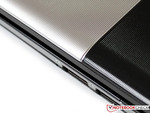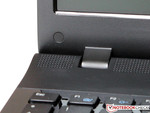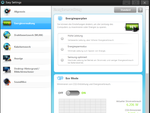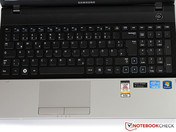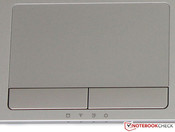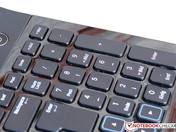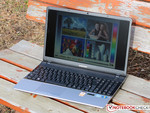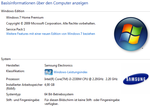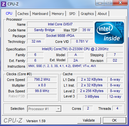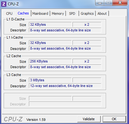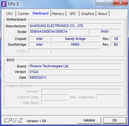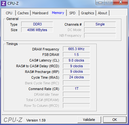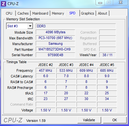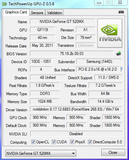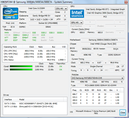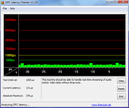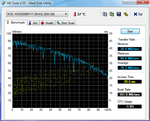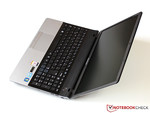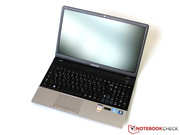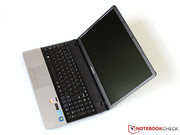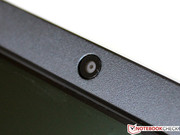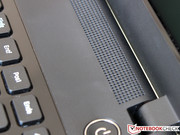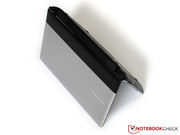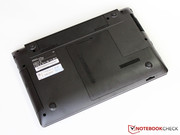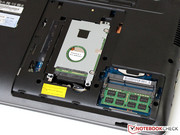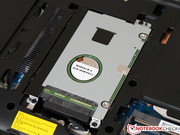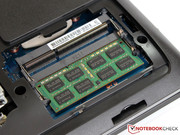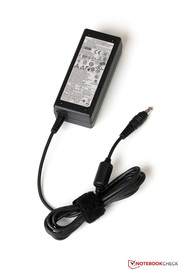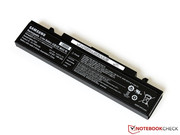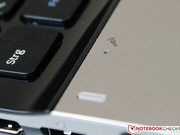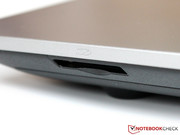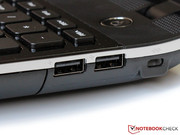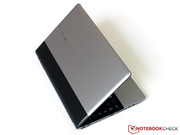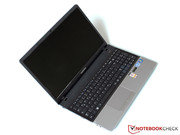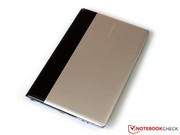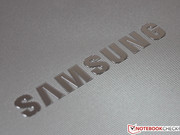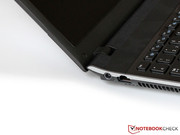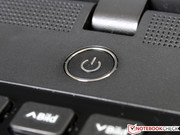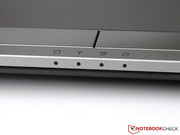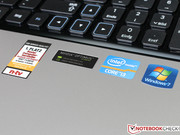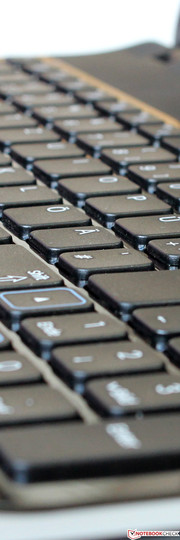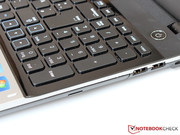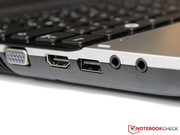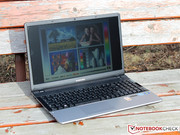Review Samsung 300E5A-S01 Notebook

Probably no other sector of the notebook market is as fiercely competitive as low-priced Office devices. Despite the overwhelming abundance of devices, many only differ in detail - those that want to stick out of the crowd have to convey uniqueness.
Has the manufacturer, Samsung, accomplished this with its Series 3 300E5A? Even current games are allegedly playable on the matt, 15.6 inch screen with an exceptionally narrow bezel. The dedicated Nvidia GeForce GT 520MX is to ensure that. Intel's Core i3-2330M takes care of the appropriate application performance. 4 GB of main memory and a hard disk capacity of 500 GB (model: S01DE) may only be average configuration specs, but will nevertheless likely prove to be sufficient for the targeted user group.
Similar all-rounders are primarily found among devices with AMD's Llano APU. The ThinkPad Edge E525 from Lenovo or even Dell's Vostro 3555 belongs to the fiercest contenders; both are available for around EUR 550, just like the 300E5A. Who will benefit from the extra cost in contrast to pure Office notebooks, such as the Asus Pro P53E?
Case
The design of the 300E5A's case is composed of elements from the 305V5A and E3520 models. The black-silver color combination can't exactly be called exciting, but it gives the laptop a quite elegant and high-end look. We already praised the wavy display's back in the past. It enhances the 300E5A's appearance and makes it particularly resistant against scratches, dust and fingerprints. The high-gloss coated keyboard surface, which Samsung should have done without, has exactly the opposite effect.
The merely 2.3 kilogram heavy notebook convinces with its compact dimensions of 368 x 243 x 33 millimeters (w x d x h), which is accomplished by its only 11 millimeter wide display bezel (15 millimeters at the top). A slightly greater use of materials would have likely not hurt the stability: Both the lack of torsional stiffness as well as the evident yielding under pressure, for example over the DVD drive or in the battery's area, seem to have room for improvement. The manufacturing quality of the used plastic is better. Material transitions and gaps hardly give reason for complaint.
The display is held fairly loosely by two hinges. Although they are pulled so tight that both hands are needed for opening, vibrations let the display teeter vigorously. Comparatively high force is needed to twist the display despite its low thickness.
Overall, the 300E5A still achieves a good rating and places itself between the contenders from Lenovo and Dell. The given features are quite satisfactory for a low-priced Office laptop, even if particularly the chassis could be a bit more solid.
Connectivity
Unfortunately, we can't find any special highlights in the Samsung notebook's scope of interfaces. Three USB 2.0 ports are available for connecting memory media, input devices or other peripherals. However, they may occasionally prove to be a bottleneck due to a transfer speed of just over 30 MB/s. The much faster successor, USB 3.0, is not supported - a big minus point compared to the Dell Vostro 3555, which has three of these ports installed right away.
When required, up to two external monitors can be connected via VGA or HDMI. However, the currently latest transmission standard, DisplayPort, has also been omitted. The list of interfaces is finished off with ports for GBit LAN, headphone/microphone (both 3.5 mm jack) and a 4in1 card reader (SD, SDHC, SDXC, MMC), which belong to the basic configuration.
With the exception of a few ports, the layout of the single interfaces seems well-considered and sensible. The USB ports are distributed on both sides of the case and very far to the rear on the right. This keeps the user's workspace clear of annoying cables. The LAN and power socket on the other side are placed just as favorably. We would only prefer to see the display ports on the rear - but that is also partly a matter of taste.
Communication
The Centrino Wireless N 100 is Intel's cheapest WLAN adapter at the moment. Accordingly, the user is tied to the 2.4 GHz band and the standards, 802.11 b/g/n. The gross transmission rate also lags behind more expensive models with a maximum of 150 MB/s - more than that is simply not possible in single stream operation (1x1 antenna layout). Bluetooth is also available depending on the configuration. It wasn't installed in our model (300E5A-S01).
A 1.3 megapixel webcam for taking pictures or videos is installed in the display bezel. The matching software, Cyberlink's YouCam, is also preinstalled. The built-in sensor is located in the midfield in terms of quality. Focus and image noise behavior can only be called usable in good lighting conditions.
As typical for Samsung, the microphone is located on the left side of the wrist rest. Voice recordings stand out with good understandability and a natural sound. However, construction-related side noise, such as typing on the keyboard or the fan's noise, are clearly audible.
Scope of Delivery
Besides the usual security and warranty information, we also find a quick start guide and a recovery DVD for the preinstalled Windows 7 Home Premium 64bit OS. More additions are included in electronic format on the laptop's hard disk. Among them, the practical Samsung tool "Easy Settings" which enables quick access to different system settings such as power management.
Maintenance
Only one screw keeps the maintenance cover closed. It can be opened quickly via a clever sliding mechanism. Access to the hard disk and memory hides under the cover. While the data carrier has to be replaced completely for upgrading, the installed memory module can easily be complemented by another one. The CPU technically supports 8 gigabyte DIMMs, but we couldn't verify whether the mainboard and BIOs can manage that in the test.
Warranty
The 24 month manufacturer warranty can be extended at various online dealers. An upgrade to a 3 year onsite service costs around EUR 60; about EUR 100 is due for a total warranty period of 4 years.
Input Devices
Keyboard
Samsung has installed a full-fledged, chiclet style keyboard including a number pad into the 300E5A despite its compact size. It is surrounded by a black, high-gloss area. We were spared from unwelcome surprises in terms of layout. All keys are placed in their usual position and have a pleasant size (letters: 15 x 15 millimeters).
The subjective typing impression convinces with the first keystroke. Inputs can be made without hitching or jamming up to the borders; the medium-firm pressure point seems well-aligned. We would welcome a somewhat rougher surface as a minor improvement. It would supply a better feedback. A longer key drop (nearly 2 millimeters) would also be advantageous. We can also recommend the notebook for quiet working environments, such as libraries, thanks to the very low stroke noise.
Touchpad
The 10 x 5.5 centimeter touchpad comes from the manufacturer Elan. Like in all newer models, it of course supports multi-touch gestures that are to facilitate scrolling or zooming, among other things. We weren't entirely satisfied with the pad's accuracy. The mouse cursor partly jerked a bit or followed gestures with a slight lurching. The gliding traits of the finely textured surface are good. Dirt and fingerprints are hardly visible on the silver-gray color.
Two big keys underneath the input field take over the function of left and right clicking. Both have a very crisp pressure point with a high quality impression over their entire length.
Regardless of the fairly good rating, the 300E5A places itself a bit behind the contenders, Vostro 3555 and ThinkPad Edge E525. While the manufacturer, Dell, can score with a keyboard light among other things, Lenovo thrills with a trackpoint that is popular among many users.
Display
The 300E5A's screen has a resolution of 1366 x 768 pixels on a diagonal of 15.6 inches. That corresponds to this category's standard resolution and amounts to a pixel density of 100 dpi. At a time where high-end smartphones already can display 1280 x 720 pixels, we would also welcome improvements in this area of the notebook sector.
Although the high maximum brightness of 268 cd/m2 sounds impressive at first, a look at the illumination is sobering. The screen's luminosity decreases steadily from left to right until not even 200 cd/m2 are reached at the right edge. Although the human eye can only interpret brightness differences logarithmically, this deviation is not only measurable, but also visible. In the end, only an average of 225 cd/m2 is on the record.
| |||||||||||||||||||||||||
Brightness Distribution: 70 %
Center on Battery: 199 cd/m²
Contrast: 130:1 (Black: 1.78 cd/m²)
37.2% AdobeRGB 1998 (Argyll 3D)
54% sRGB (Argyll 3D)
35.96% Display P3 (Argyll 3D)
The disappointing black value of 1.78 cd/m2 results in a modest contrast ratio of 130:1 - strong evidence for a low-end TN screen (Samsung LTN156AT190). Potential customers won't be comforted by the fact that other manufacturers don't install better screens in this price range either. The heavy price war on the market virtually forces the companies to shy even the smallest additional expenditure - regardless of a possible added value.
The color spectrum also doesn't meet high requirements. The 300E5A can't cover the important sRGB and AdobeRGB standards needed for professional image processing. But that won't likely have an effect on most customers. This drawback will hardly be noticed subjectively in everyday use.
The notebook is quite legible even outdoors due to its non-glare surface. Regardless of that, a stronger backlight would be appreciated for use in direct sunlight - especially since the brightness is reduced slightly on battery power in contrast to AC mode. In view of the long battery life, which we will look at more closely later, this is actually an unnecessary restriction. The 900X3A, also from Samsung, shows how a perfect screen for outdoor use should look like.
We observe the typical behavior of an inferior TN screen when examining the viewing angle stability. The slightest upward deviations are rewarded with intense fading and downward movements let the displayed content darken. Horizontally, the contrast first decreases at a somewhat larger angle of approximately 20 degrees. That at least allows enjoying a movie together with another person. Nevertheless, it is an overall sobering though not unusual result.
The analog VGA port is especially disappointing in high resolutions due to a flickering and unfocused representation. When available, the also installed HDMI port is the far better choice for connecting an external monitor.
Performance
We know the Intel Core i3-2330M very well as midrange dual core processor from the Sandy Bridge architecture. With a clock frequency of 2.2 GHz and SMT technology support, the CPU is armed for almost all up-to-date applications. However, the buyer has to live without a Turbo mode in contrast to the Core i5 and i7 range models. The TDP of the processor, equipped with a 3 MB L3 cache, is 35 watts. Further information can be found on the information page of our CPU database.
Besides the Intel HD Graphics 3000 integrated on the i3-2330M's die, the manufacturer installs an additional, dedicated Nvidia graphics solution. The GeForce GT 520MX is based on the GF119 chip, like the somewhat slower GT 520M. The card is only located in the entry-level sector due to 48 shader ALUs and 8 TMUs, although the clock frequency is high 900 MHz. The 1024 MB DDR3 VRAM, which is addressed via a narrow 64 bit memory interface, clocks just as high. With support from Nvidia's Optimus technology, it's possible to switch between both graphics cards depending on the application.
The further configuration includes a hard disk with a capacity of 500 GB and a 4 GB memory module (DDR3-1333) from Samsung. In view of the still low RAM prices, we would have preferred 6 or 8 gigabytes right away. However, the buyer can upgrade it when required (see Maintenance).
Processor
The i3-2330M reaches the expected performance in both AC mode and on battery power without irregularities. We achieved 3624 points, respectively 7942 points in Cinebench R10.5 (single/multi thread) (64 bit version). The latest Cinebench R11.5 resulted in a score of 2.11 points (64 bit version). The A8-3500M in both the Vostro 3555 and the ThinkPad Edge E525 can't compete with these performance rates; both lag behind by 10 to 45 percent depending on the test.
When computing-intensive software is used on a regular basis, the sister model, 300E5A-S05, should be considered because it has a fast Core i5-2450M besides a bigger main memory (6 GB). It can surpass the i3-2330M by over 30 percent due to Turbo Boost and a higher base rate; the additional cost of around EUR 60 is within an acceptable range. However, this difference in performance will hardly be noticed during routine operations, such as Internet surfing.
Mass Memory
The user has a 500 GB, 2.5 inch hard disk from Western Digital available for data (WD5000BPVT-35HXZT1). Samsung divides it into two volumes of 177 and 265 GB. The remaining capacity is hidden invisibly in a recovery partition.
The characteristics of the drive (5400 rpm, 8 MB cache) only give hope for average performance rates. This is confirmed by our measurements in HDTune and CrystalDiskMark. The sequential read and write processes achieve an average of approximately 70 MB/s. The access speed is 20.6 milliseconds.
An SSD could particularly speed up the loading time of programs or the booting process (approx. 40 seconds). However, that first belongs to the basic configuration of much more expensive devices. An ExpressCache, like in Samsung's 700Z3A, would also have been great as a less expensive alternative - but it's unfortunately not included, either.
System Performance
We use the synthetic PCMark from the manufacturer Futuremark to classify the system performance. It checks processor, graphics card and hard disk alike. 4897, respectively 1561 points in PCMark Vantage and PCMark 7 is located exactly between the ThinkPad Edge E525 and the Vostro 3555. Stronger Office notebooks with a Core i5 processor, such as the Asus U56E, can break away by a few percentage points.
The 300E5A makes a very powerful impression in everyday use and doesn't leave the user wanting faster hardware very often. The notebook can deal with routine Office applications without any restrictions.
| PCMark Vantage Result | 4897 points | |
| PCMark 7 Score | 1561 points | |
Help | ||
Graphics Solution
Unlike most immediate contenders, our test device doesn't have to be satisfied with an integrated graphics card. It can fall back on the Nvidia GeForce GT 520MX in 3D applications. It isn't only subjectively faster than, for example, Intel's HD Graphics 3000, but also has DirectX 11 support and a state-of-the-art video decoder.
Programs, like 3DMark Vantage (Performance preset), make it evident how big the performance difference between these two graphics solution is: 2681 points surpasses the Asus Pro P53E with only 1386 points by almost 100 percent. 3DMark 11 doesn't run on the Intel IGP, based only on DirectX 10.1. 674 points approximately correspond to the performance level of AMD's A8-3500M-APU with a Radeon HD 6620G.
| 3DMark 03 Standard | 13782 points | |
| 3DMark 05 Standard | 10556 points | |
| 3DMark 06 Standard Score | 5357 points | |
| 3DMark Vantage P Result | 2681 points | |
| 3DMark 11 Performance | 674 points | |
Help | ||
Gaming Performance
These additional performance reserves in the graphics field should also make the 300E5A capable of rendering current games smoothly. As long as the user only uses low to medium settings, it's even possible to select the native display resolution of 1366 x 768 pixels.
We could still achieve excellent 86 fps even with additional two-time anti-aliasing and high details in the rather graphically undemanding soccer simulation Fifa 12. In return, fans of the racing games, Dirt 3 and F1 2011, have to be satisfied with 1024 x 768 pixels and slightly reduced details. Then it's also possible to play these two tracks without restrictions.
The newest scion of the popular building strategy series, Anno 2070, has a much higher demand on the graphics performance. Even though it's possible to play this genre with comparatively low frame rates, our medium pre-settings (details visible via mouse-over in the following chart) are too much for the weak GeForce GT 520MX.
Compared to the lower clocked GeForce GT 520M, the performance gain is approximately 20 percent. Even the Radeon HD 6620G from AMD's Llano APU lags behind a bit, though it was on a par in 3DMark 11. However, should the user have serious gaming ambitions, we would recommend taking another notebook with a midrange graphics card right away, for example the approximately 50 percent faster GeForce GT 540M or the Radeon HD 6630M. The Samsung 300E5A remains to be an Office laptop with slightly better gaming suitability, but nothing more.
| low | med. | high | ultra | |
|---|---|---|---|---|
| Call of Duty: Black Ops (2010) | 62.6 | 40.6 | ||
| Dirt 3 (2011) | 101.2 | 41.4 | 27 | |
| Deus Ex Human Revolution (2011) | 62.6 | 26.3 | ||
| F1 2011 (2011) | 66 | 47 | 27 | |
| Fifa 12 (2011) | 218 | 107 | 86 | |
| The Elder Scrolls V: Skyrim (2011) | 31.3 | 21.8 | 14 | |
| Anno 2070 (2011) | 55.3 | 21.2 | 13 |
Emissions
System Noise
The notebook's fan is usually completely disabled during normal Office use or video rendering and no noise is audible - we measure a minimum of only 29.6 dB (A). Even hard disk accessing doesn't exceed 30.7 dB (A). Users who also want to keep the noise level as low as possible during light load can enable the so-called Silent Mode. It throttles the CPU to 800 MHz and thus reduces the consumption. However, it also limits the performance significantly at the same time.
The noise level increases considerably during full load and finds its peak at 41.9 dB (A). The high-pitched noise can become a major disruptive factor in the long run, even if the noise level drops again after a short period of idling. The very quiet ThinkPad Edge E525 shows that this can be solved better.
Noise level
| Idle |
| 29.6 / 30.6 / 31.9 dB(A) |
| HDD |
| 30.7 dB(A) |
| DVD |
| 34.3 / dB(A) |
| Load |
| 41.6 / 41.9 dB(A) |
 | ||
30 dB silent 40 dB(A) audible 50 dB(A) loud |
||
min: | ||
Temperature
The Samsung 300E5A's exterior isn't conspicuous at first: There is hardly a noticeable temperature increase when idling. The temperatures range between 20 to 25 degrees Celsius on the top. The rates of the laptop's bottom are a bit higher with 30 degrees Celsius, but have to also be called exceptionally cool.
Although the hardware works hard in our stress test, the case gets lukewarm at most. The temperature only increases to a high 45 degrees Celsius in the area of the vent. Nevertheless, the notebook can also still be used on the lap without hesitation. The user won't get sweaty hands in the summer either thanks to the cool wrist rest.
It becomes evident why the fan has such a hard time anyway when looking inside the case. The simultaneous load through FurMark and Prime95 lets the processor's clock rate drop to approximately 1700 MHz after a while. However, the core temperature of 84 degrees Celsius seems to be remote from critical rates. The graphics chip heats up to 83 degrees Celsius, but we didn't observe throttling here.
The CPU's premature throttling seems a bit overdrawn in our opinion. But the reason for it becomes evident in the following power consumption assessment. We neither observed any clock or performance losses during real applications nor in the benchmarks executed directly after our stress test.
(+) The maximum temperature on the upper side is 35.8 °C / 96 F, compared to the average of 34.3 °C / 94 F, ranging from 21.2 to 62.5 °C for the class Office.
(±) The bottom heats up to a maximum of 45 °C / 113 F, compared to the average of 36.8 °C / 98 F
(+) In idle usage, the average temperature for the upper side is 23.3 °C / 74 F, compared to the device average of 29.5 °C / 85 F.
(+) The palmrests and touchpad are cooler than skin temperature with a maximum of 29 °C / 84.2 F and are therefore cool to the touch.
(±) The average temperature of the palmrest area of similar devices was 27.6 °C / 81.7 F (-1.4 °C / -2.5 F).
Speakers
The small stereo speakers in the 300E5A achieve quite an remarkable maximum volume for an Office notebook. It's no surprise that the sound quality comes too short for the most part. Compared to the very present trebles, the midrange and particularly the basses are extremely neglected. Moreover, playback sounds unnatural and tinny.
The various sound modes improve this a bit. The modes can be found under the menu item "Sound Alive" in the aforementioned, Easy Settings. We liked the setting "Movie" the most, because it generates a dynamic and balanced sound impression. Nevertheless, connecting external speakers via the 3.5 millimeter jack or HDMI should be preferred, if a modern AV receiver is available.
Battery Life
Power Consumption
The Samsung 300E5A convinces with an extremely low power consumption of merely 7.1 to 10.8 watts when idling thanks to dynamic graphics switching via Optimus. Despite a significant improvement over older AMD platforms, the Llano in form of the A8-3500M can't quite compete with such low rates. Both the Vostro 3555 and the ThinkPad Edge E525 consume marginally, but nevertheless measurably more.
This condition changes drastically as soon as the CPU is loaded to capacity and the dedicated Nvidia graphics card is enabled: With up to 66.3 watts in 3DMark 06, the notebook likely comes dangerously close to the limits of the compact power adapter specified for a maximum of 60 watts (plus power efficiency losses). A higher power consumption isn't achieved even in our stress test (61.9 Watts) due to the previously described throttling. Apparently, protective mechanisms are enabled to prevent a possible overload.
At first, we were surprised about the high rates in view of the installed components. It would be conceivable that the high core clock of the GeForce GT 520MX (900 MHz) is responsible for the chip's comparatively high TDP - official information on the part of the manufacturer, Nvidia, are unfortunately not known to us. The similarly equipped Asus Pro P53E, without an additional graphics card, proves to be a lot more energy efficient with 34.1 to 42.5 watts.
| Off / Standby | |
| Idle | |
| Load |
|
Key:
min: | |
Battery Runtime
Despite the small 48 Wh battery, our test device is a real runtime miracle: 9 hours on battery power in BatteryEater's Reader's test - not every notebook manages that. Comparable laptops with an AMD APU only achieve about 6 hours.
When we set the brightness to a reasonable level of 150 cd/m2, enable WLAN and surf on the Internet, the battery runtime drops to a still excellent 6 hours and 23 minutes. Even two movies in a row are possible without recharging.
The 6 cell battery's reserves are drained after 97 minutes of load by BatteryEater's Classic test at the latest. This rate can also be a bit lower depending on how much the single application loads the graphics card - for example in games.
Verdict
It is a fair deal that Samsung presents to prospective buyers of the 300E5A. The consumer gets a versatile notebook that isn't only just suitable for boring word processing for around EUR 550.
The great mobility counts to the biggest advantages of the device: A weight of only 2.3 kilograms, equipped with a matt screen and, when required, on the move for almost a whole workday without a power adapter - it's a pleasure to be accompanied by such a companion. The good workmanship and the good keyboard are also appealing. The GeForce GT 520MX could be the icing on the cake: In contrast to the usual Intel graphics card in this category, it supplies a noticeable performance gain and thus nothing should stand in the way of an occasional game.
Unfortunately, it seems that the graphics card is primarily responsible for the high power consumption during load, and it even brought the included power adapter to its capacity limits. The consequence is throttling and a high revving fan.
Two AMD based alternatives are available in the Vostro 3555 and the ThinkPad Edge E525, which have their charm despite the processor's somewhat lower performance. Especially the Dell notebook stands out with USB 3.0 and an above average configuration. The Radeon HD 6620G integrated in the A8-3500M is also just as energy efficient as it is fast. However, users who don't put much value on 3D performance should take a closer look at the Samsung E3520 or the Asus Pro P53E.




